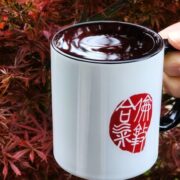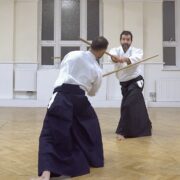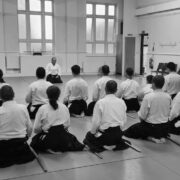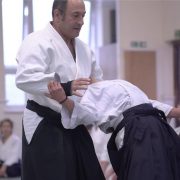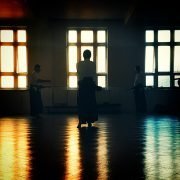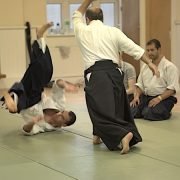“What the hell do you think this is all about?”
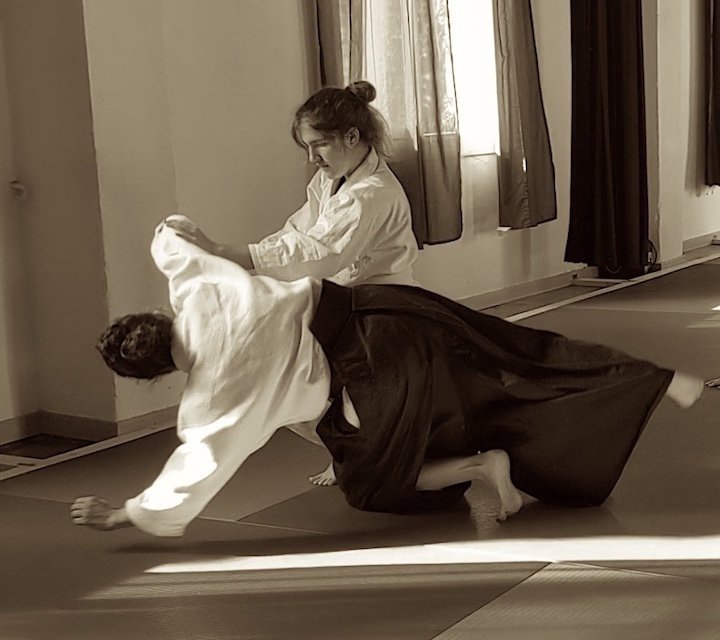
The Southwestern Aikikai as it was known consisted of the Albuquerque and Santa Fe dojos in New Mexico. Albuquerque was the larger city and where I lived but Santa Fe was the pretty one, nestled below the Sangre de Christo mountain range and the capitol of the state. The Santa Fe dojo was a special place, a legacy of the late Nakazono Sensei who established himself there in the early 1970’s. I felt quite honoured to have been the teacher there in his dojo, built by his students many years before. A beautiful adobe brick place on St Francis where the southwestern sun would warm it up and with shafts of light pouring in to create the most wonderful ambience. It was however in Albuquerque in 1989 or 1990 where I had also been the Head instructor for a few years and where I would invite Chiba Sensei a couple of times a year for weekend seminars and it was during one of those weekends that he chose to make a particular point and drive it home.
The last session was an hour of ikkyo on our knees, which he would describe as a misogi or purification type of training. He would humour us that this process would help us purge the 108 sins that Buddhism believes we all suffer from. He personally and not surprisingly, thought we had many more sins than that. An hour of this is tough and if you ended up with someone who liked to have a rumble then you had your work cut out for you. It was something we would all do on Ueshiba’s memorial day, April 26th and also for the New Year. We were all thoroughly tired by the hour when he seemed to end the class and therefore the seminar. Instead he got us all to sit around him and decided to talk to us. He took a pause, closed his eyes and started very deliberately “I want you to all think about what you have just done. Ask yourselves, honestly, how much of what you did was correct or wrong or something else.” “Close your eyes and think carefully on this.” The room went quiet for a while as everyone seemed to consider what was asked of them.Finally and after 5 or so minutes he started to talk again “OK have you thought about what I asked?” Murmuring of vague yeses and a couple of nodding heads followed. After a while he asks “So who goes first?”
Here we go.…
“I think I got most of it right, I would say 90%” was the answer from one person. The next “Errm, yes I agree with him, about 90%, no one gets 100% do they?”
“Anyone else?” Chiba Sensei asked. So the answers poured in one by one. Some were more modest as they said a mere 50% was right. There were other variants and I think by now you can see how this would all unfold? I was not to contribute to this q&a, not on this occasion.
After a while it would naturally return back to Chiba Sensei himself. He would once more pause, close his eyes and appear deep in meditation. “Hmm, I got 3 right, maybe 4 but I would have to think about the last one as I am not sure yet.” He said this with considerable aplomb. Well it wasn’t much of a surprise when everyone looked caught off balance. His words were clearly designed to do this. Some would look at each other, maybe searching for an answer “What does he mean, I don’t understand.” So he returned to the participants. “Why do you think you got so many right, what criteria do you use for what is right and wrong ikkyo, right and wrong Aikido?” The answers that followed were either muddled or the usual predictable corporate platitudes. “The “connection” was good, the movement flowed well, the “form” was correct and other similar expressions.” How many understood what they were saying, or were simply repeating parrot like was difficult to say. Maybe they were just saying what they thought was expected from them?
There was no “magic” here. It was a simple class, with arguably the most basic of moves to practice amongst ourselves. We had executed these ikkyo 1000’s of times over months and years, for some even decades and so surely many of us “knew” what they were all about or at least had some idea. You would think. Yet here stood, sat actually, not only a renowned master but one of the greatest exponents of Aikido of our time, who said without any irony, that he only got 3 correct and he wasn’t sure about the 4th one. It seemed like a head job or a comedy moment but it was neither. He was deadly serious and I’m not sure if it was taken on board as such, if indeed any kind of understanding was garnered from his intent, or was it actually his “challenge”.
To my mind it was definitely a challenge. Maybe not in your face type of challenge, like a couple boxers about to go head to head but a most assuredly “what do you think you are doing”, or was it more of a “what the hell do you think this is all about?” He was succinct in his meaning and precise as a man of Budo would be. “What is ikkyo, which is to say what is Aikido and what is it you look for, what do you use to measure the quality of your training?”
Talk of ikkyo also reminded me of a session back in San Diego where we would train together sometimes. If you don’t know about weight you found out very quickly as a shomenuchi, vertical cut from TK Chiba Sensei was unlike any other. It was Mjölnir and it could drive you many feet under the mat. He was one of those rare beings that could simply deliver enormous power at any time and place of his choosing. I think for him the challenge was not this God given ability but how to channel this and reign it in to be a great teacher rather than just a good one. Anyway, him knocking me into the ground was no big deal, I could take it and he would just chuckle to himself. What was even harder was to try and get it done on him, the application, the execution of a clean and technically correct kata number one. It was like moving an elephant, not that I have ever done that. I was strong, fast and very agile and with considerable endurance and absolutely none, I repeat ABSOLUTELY none of it helped me. It may start OK but I would end up directing every ounce of strength and energy I could summon to this end. After 10 or 15 minutes I was sitting in a puddle of my own sweat. Every part of me was burning. Top to toe, every cell and parts you never knew you had. In the end he called it what it was. “You are strong and fast and determined but none of that will work against me.” Again he was succinct and as he often would be, brutally honest. He could have been making a clear statement of – I am stronger, better and faster than you. He was however the consummate coach, totally professional and would bend over backwards to try and pass his teachings on. If you were true to learning he could not do enough. “If you want to get ikkyo, you’re going to have to figure out more than that young man.” A challenge to self examine, to look deeper and open your eyes to your own training was the order of the day here.
I return to that afternoon in Albuquerque and the question Chiba Sensei presented to everyone remains as true today as it ever did. “How many good ikkyo’s did you do today?”

